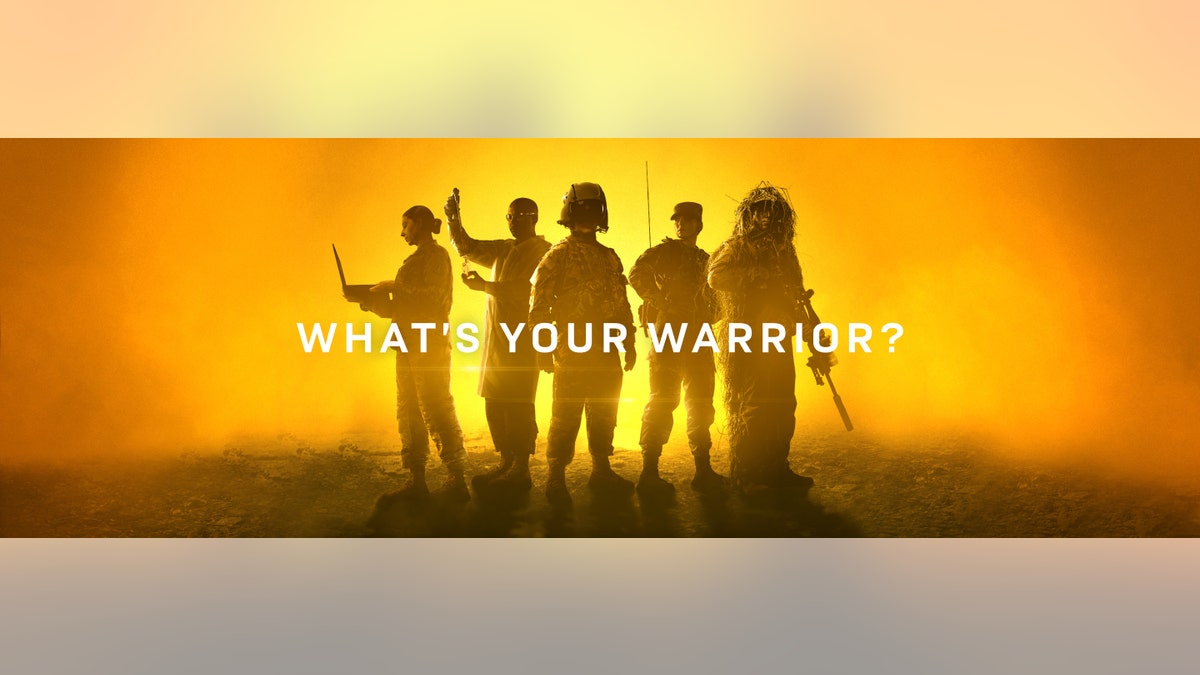
'What's Your Warrior' campaign graphic. (U.S. Army)
Maneuvering attack helicopters through mountains, firing lasers from ground vehicles, commanding autonomous robot sensors, waging cyberattacks and creating microscopic explosions splitting cells in a laboratory — are all images designed to capture a growing realm of Army experiences depicted in the service’s massive new ad campaign called “What’s Your Warrior?”
Beginning with images of Apache helicopters weaving through rocky cliffs amid dust, wind and high-risk combat, the Army-colored greenish-yellow video animation balances a nuanced message, blending individual soldier specialties with platforms, networks and advanced weapons being used by “teamed” groups of soldiers.
The ads show snipers buried in tall grass battling high winds, paratroopers descending in groups through morphing yellowish-clouds and cyberwarriors typing feverishly while satellites, sensors and command and control technology simultaneously operate in tandem.
Seeking to appeal to a sense of identity, profession and purpose within the cyber-savvy information-age informed Generation Z, the Army’s new recruiting advertisements intend to take news steps beyond the famous “Be All You Can Be” ads by, among other things, expanding the definition of Warrior.
SOLDIERS USE AI TO FIRE PRECISION GRENADES, GUIDE DRONE ATTACKS
Networking weapons from space, guiding ground missile targeting from drones in the air, jamming enemy networks with EW, using AI to organize armored vehicle sensor data and pushing the frontiers of scientific discovery in laboratories — are all skill sets now increasingly in demand by Army recruiters.
While the fundamentals of mechanized warfare, including the Army’s Combined Arms Maneuver, are now needed as much or more than any time in modern history, the Army is, of course, expanding its mission scope to encompass space, cyber, EW and AI-driven weapons systems. Therefore, as the ad campaign reflects, the service needs more cybersecurity experts, scientists, researchers and innovators to join the ranks of Army professionals now exploring the boundaries of technical possibility in preparation for great power warfare.
Recognizing the fast-moving pace of technical change, and its impact upon modern warfare, Army professions and opportunities are now broader than they have ever been in history, Brig. Gen. Alex Fink, Chief of Army Enterprise Marketing, told Warrior in an interview.
The Army is well-known for its tanks, snipers, missiles and attack helicopters, Fink explained, so the ads seek to emphasize an ever-expanding world of new opportunities available for young recruits. The music, scenarios, graphics and storylines depicted in the video ads were deliberately chosen to reflect a new kind of modern warfare complexity, Fink told Warrior.
ARMY SOLDIERS USE 'MACBOOK'-SIZED TABLET TO OPERATE MULTIPLE SMALL DRONES
An Army report described it this way: “'What’s Your Warrior?' plans to tie aspirational warrior identities to the Army’s 150 unique careers and eight broad specialty areas, including Signal, Air & Space, Cyber, Science & Medicine, Engineering, Support & Logistics, Intelligence and Ground Combat."
The widening scope of Army missions and specialties, it would seem self-evident, is likely to improve post-Army career transitions for soldiers as well, a phenomenon described in an interesting essay by West Point's Modern War Institute.
“A 2006 study showing that male military officers are three times more likely than other American men to become CEOs is an example of a strong data point that recruiters can leverage,” says the article, called “It’s Not The Economy: Why The Army Missed Its Recruitment Goals and What to Do About It.”
While scientific innovation has always had great significance to the Army, it is becoming even more crucial and spread throughout the service. There seem to be several reasons for this; not only have Russian and Chinese military technology advancements raised concern at the Pentagon, but war systems are increasingly reliant upon computers, networking systems and AI-enabled weapons.
ARMY TO TEST AND SHOOT WEAPONS AT NEW MOBILE PROTECTED FIREPOWER PROTOTYPES
Most weapons systems are already engineered with various degrees of computer technology. Everything from wireless networks connecting weapons’ sights to night vision, long-range thermal infrared sensors in Army tanks and helicopter navigation and targeting are already integrated with advanced computer processors. Naturally, this reality greatly multiplies the number of advanced technical specialties needed in the Army.
The West Point essay reinforces this point, stating that the Army needs “technologists, data scientists, and computer programmers” … and goes on to cite some of the advantages of military service as compared to the private sector. “While Fortune 500 companies have competitive remuneration packages, the military offers a unique opportunity for America’s brightest minds to apply themselves to complex defense problems,” the essay states. (James Long)
By combining cyber missions with satellites, aviation and ground war, the ads seem to, by design, represent the uniquely modern complexities presented by multi-domain warfare.
CLICK HERE TO GET THE FOX NEWS APP
Fink explained that the campaign will be unveiled in waves, or chapters, over time to unfold an evolving storyline. The well-known “Be All You Can Be” began in the 1980s, spanning decades into 2001. The new “What’s Your Warrior” phrase builds upon this call to excellence by further emphasizing team and highlighting the growing number of professional opportunities available to Army recruits.




















